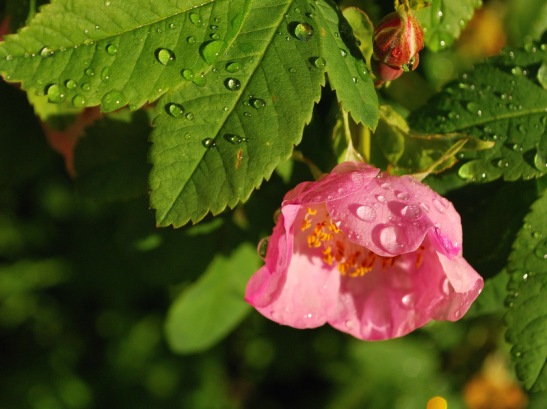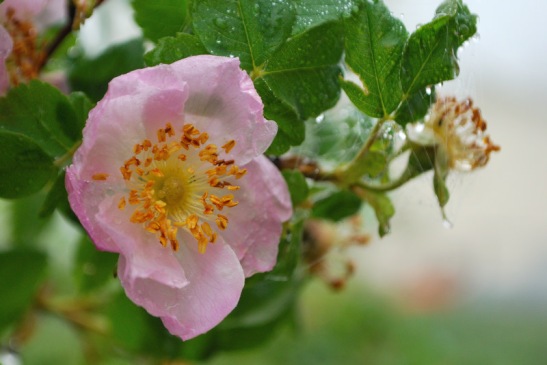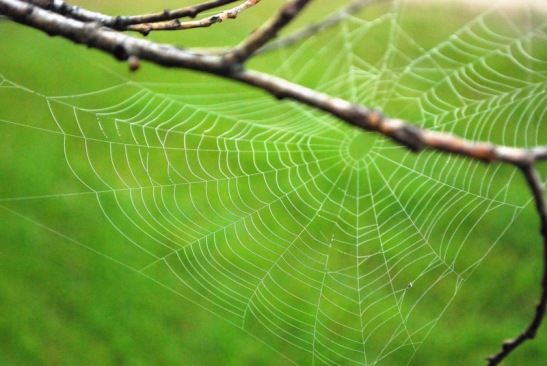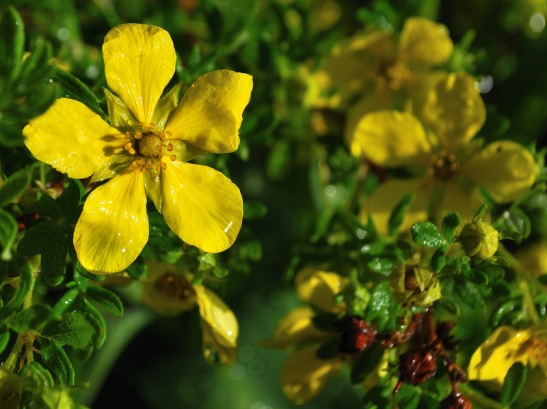On and Over the Hills
"Go as far as you can see; when you get there you'll be able to see farther." ~ Thomas Carlyle
Pursuing Light’s Pigments
“There are two kinds of light – the glow that illumines, and the glare that obscures.”
~James Thurber
Prickly Rose – Early Morning – After Rain. July 7, 2011. 6:50 a.m. Camera settings: 1/500 sec @ f/9, -0.3EV, 55mm, ISO 400, Auto focus, RAW file corrected for exposure, colour and sharpness, and converted to TIF in Nikon’s View NX. Cropped in and exported via Picasa.
It is all about the light: that whimsical, ever changing, shadow-shifting, colour defying element; as indefinable, as ungovernable, as illusive as a deity; at once bewitching and unnoticed.
Shasta Daisy – Early Morning. July 15, 2011. 6:51 a.m. Camera settings: 1/160 sec @ f/11, -0.3EV, 55mm, ISO 200, Auto focus. RAW file corrected for exposure, colour and sharpness, and converted to TIF in Nikon’s View NX. Exported via Picasa.
The light of moist air shot through with birthing sunshine is the twinkle in the eye of a just-awakened sky; the light of mid-day: hard, judgmental, revealing; the light of evening, casting silken coral softness on flesh and feather. Then there are the lights allowed to pass through leaden skies and those drifting among the mists of a summer afternoon.
Prickly Rose Through the Fog. July 12, 2011. 8:50 a.m. Camera settings: 1/125 sec @ f/5.6, -3.xEV, 55mm, ISO 400, Auto focus RAW file corrected for exposure, colour and sharpness, and converted to TIF in Nikon’s View NX. Cropped in and exported via Picasa.
If you have travelled, you may have noticed the varying character of light on different continents. Many years ago in Australia I tried to paint the soft, almost touchable light of Australia. I’ve tried to photograph the romantic light coming through a lace-covered window in early evening and daydreamed under the cozy light pushing past gently dancing leaves and through the canvas of a tent.
Poppy through Wispy Cloud. July 15, 2011. 10:25 a.m. Camera settings: 1/1000 sec @ f/5.6, 0EV, 55mm, ISO 100, Manual focus. RAW file corrected for exposure, colour and sharpness, and converted to TIF in Nikon’s View NX. Cropped in and exported via Picasa.
I heard about it. I read about it. I saw it and knew it, and yet it alludes me. Nathaniel Hawthorne is to have said that sunlight is painting. It seems to me that sunlight’s palette is limitless, and its canvas is constantly being overlaid with new and finer dabs of pigment. Define the colour of a white poppy. See it in the morning when the clouds are painted pink. Look again when storm clouds have gathered and its stony opacity defies the delicacy of its blossom. Look at it from beneath when the sky is so blue in mid-afternoon that the orange and yellow candy of a bumblebee can be seen through the petals.
Geranium. July 8, 2011. 8:21 a.m. Camera settings: 1/100 sec @ f/5.6, -0.7EV, 55mm, ISO 100, Auto focus. RAW file corrected for exposure, colour and sharpness, and converted to TIF in Nikon’s View NX. Cropped in and exported via Picasa.
Over and over again, I read the mantra of the landscape photographer. “Shoot when the sun is low, just after sunrise and just before sunset.” And yet I carry my camera in the middle of the day, trying to pull details from shadows and sun-washed highlights. I thought they were talking about shooting the ethereal colours of the clouds when the sky sings the aria of dawn and the ballad of the dusk.
Allium. July 8, 2011. 8:22 a.m. Camera settings: 1/100 sec @ f/8, -0.7EV, 55mm, ISO 100, Auto focus RAW file corrected for exposure, colour and sharpness, and converted to TIF in Nikon’s View NX. Cropped in and exported via Picasa.
But they were not. These wise advisors were talking about colour and the softness of shadows. They knew about the frisky light that crouches down and peeks under the skirts of draping branches, the light that reveals through the translucency of petals and leaves, and that exposes the spider’s deadly designs.
Orb Web on Foggy Morning. July 14, 2010. 7:22 a.m. Camera settings: 1/320 sec @ f/5.6, -3.xEV, 55mm, ISO 1600, Manual focus. RAW file corrected for exposure, colour and sharpness, and converted to TIF in Nikon’s View NX. Exported via Picasa.
I will still carry my camera through the woods and around my garden in the middle of the day because it records for me the treasures I find. But if I can surprise one of these jewels when it has not yet dried its face after the morning dew has washed it, or visit it again when the sun is telling it its bedtime story, then I am all the more excited by its brilliance, its delicacy, its beauty and its, and our silent and crucial connection to the cycle of earth’s rotation.
Potentilla. July 9, 2011. 8:22 a.m. Camera settings: 1/320 sec @ f/8, -0.7EV, 55mm, ISO 100, Auto focus. RAW file corrected for exposure, colour and sharpness, and converted to TIF in Nikon’s View NX. Cropped in and exported via Picasa.
As you can see, I have decided to take a page from Bob Zeller and include my EXIF data under the pictures here. I seem to only be able to learn one thing at a time and in the almost two years that I have had my DSLR, I’ve so far I believe I understand aperture and shutter speed. I am starting to remember to consider my ISO and am currently experimenting with exposure compensation (EV).
Unless I know I want to try to catch or stop movement I always shoot in aperture priority and I have not even tried to learn about focus modes, metering and the dozens of other things I could adjust on my camera. I have one camera – a Nikon D60 with the kit 18-55mm lens. Sometimes I remember to use the lens hood (and to reverse it when I don’t need it) and occasionally I go out with my (broken) tripod to take bracketed exposures (manually – my camera doesn’t do it automatically) to blend. I use the wireless remote that came with the camera. I don’t have any flash units other than what is on the camera and I seldom use it.
So, if you can learn anything from the shooting information, even if it’s what not to do, that’s great, but if you see how I might have improved the shot by doing something differently, that’s even better and please jump in with your advice to help me, and possibly others who stop in, to learn.













Your words are pure poetry!! I have also recently learned about EV settings from none other than Mr. Zeller!! 😉 It sure does help with trying to capture little details in those delicate petals. Beautiful job!! 🙂
Thank you Holly. I’ve been watching Bob’s settings as well and learning quite a bit – not the least that I won’t be taking bird pics any time soon. (or Zoom) 🙂
Been wondering where you were. Now I know! These are beautiful. I am, as was Monet, particularly partial to a backlit subject. You simply continue to amaze me. ~ Lynda
I just have my fingers in too many pies, Lynda. Wish I could eat them all, but I would surely burst. I’ve had a little time off of work, so today was for writing, tonight and tomorrow I’m going to try to catch up on some reading, the next day…who knows (depends on the weather).
I’ve just begun to feel like I have some idea of how to properly expose for backlighting. There are so many variables. I too love the feel of such images (and Monet, of course). Thank you so much for your encouragement. I’ll ‘see’ you soon.
A very poetic text to remind us of the ‘key ingredient’ of photography. And your pictures prove the point. I especially like the Poppy through Wispy Cloud. It seems to show that you do not necessarily need ‘nice’ weather to make good pictures. (Which I still had to learn over the past couple of years.)
Just as an aside, I did not know the metaphor – or idiom – of having one’s fingers in too many pies: I enjoyed it! Thanks, Cindy.
Perhaps you are familiar with “too many irons in the fire”. It is the same. I am constantly battling with myself to not start something, because I can never spend as much time as I like on any one thing. On the other hand, I have a dozen different projects to choose from and if I’m neglecting eleven of them, at least I am accomplishing one. I still haven’t caught up on my reading and here it is another weekend already. I will be by to see what you have created with that terrific graphic eye of yours.
I was pleased with the poppy picture too as well as the rose in the fog. I find it difficult to achieve the desired atmosphere with close, rainy weather – the cozy, quiet, kind of melancholy feeling that pervades such days. ‘Nice’ weather is much simpler to depict.
Thanks for your thoughtful comment Tobias. I appreciate your coming by.
Such beautiful photos, just love the freshness and the delicacy of the flowers! Amazing light indeed in all of these and love your input!
I am delighted that you enjoyed the post, Rose. Flower pictures can be so cliché but I can’t help but be inspired by just that same freshness and delicacy that you write about. Thank you for your visit and comment.
As usual, a beautiful job, both of the flowers and the narrative. I like the way you reduced the EV as it has brought out the detail of the petals. But I must say, you and Holly give me far too much credit. I only pass on what works for me. You guys have taken it further and are really getting into it. Heck, I don’t even shoot RAW anymore. The old JPEGs work for me. (Meaning I don’t know how to make RAW work for me.) But I admire how you and Holly are making the RAW do so much more for you. Of course, it could be that the other software that I use, makes up for it. After all, it is the end product that is important.
Your flower photos are smack right on the money. I’m glad that I don’t have to choose a favorite. As you infer, it is all about the light. On that note, I am so much like you. I don’t pay any attention about what time of day it is, I just make whatever kind of light is available work for me. Of course, my favorite light, is the slightly overcast, or partly cloudy type. But here where I live, both are hard to come by.
Bob, I think I agree with you here: “I don’t pay any attention about what time of day it is, I just make whatever kind of light is available work for me.” Sometimes even noon light can work for you. Sometimes you need long shadows to state your point, and at other times you are best off with no shadows at all. Like so often, there is no general rule. This said, I fully agree that morning and evening can be very stimulating and inspiring … just the way Cindy said it.
I have been experimenting with the combination of adjusting ISO and EV. There is so much flexibilty there, that it has been hit and miss. I can’t wait for the day when I can set my camera by instinct. You made me think about shooting RAW. I do prefer the results I get, but I don’t have Photoshop, so can’t use a lot of the other software either. However, I have been shooting up to one hundred wildflower pictures per day lately (the window of opportunity is very short here), so I set my camera to shoot both RAW and JPEG and it is shortening my computer time considerably. That way I don’t have to take the time to process the RAW unless I am really unhappy with the JPEG. Thanks for making me think about that. And yes, I’ve been shooting in the middle of the day because that’s when I can get out (long breaks from work – I’m setting my own hours right now). The weather has been cooperating up until today (it’s raining). Most days there have been enough light clouds in the sky to allow me to get good detail in the flowers. Thank you for your detailed comment, Bob. You know I appreciate it.
I agree, Tobias. Mood can be injected in all kinds of ways. The sentimentality of morning and evening colours can be a boon or a crutch.
Lovely, lovely… To look and listen through your eyes.
Thank you.
Now that I have the lump out of my throat, can you tell me if this is the famous “Wild Rose of Alberta”? So fabulously delicate in shade and form.
I think I have this same perennial Geranium here (I believe she’s named after a very famous British gardener? So famous I can’t recall her name – my bad; ) but she is the perfect illustration of your essay. I absolutely love her daily colour metamorphosis, but most particularly the ethereal magenta to cornflower blue at the “golden hour”. Again, thank you, D
My sincere apologies for being so late in answering your question, Deb. Yes, that is indeed the famous rose. There is another in the province that is actually more common, (common wild rose) at least throughout the prairies. You can tell the provincial flower by the spiny branches and stems. The other has larger thorns, but mostly at the stem nodes.
If you think of the name of the Geranium, please let me know. This is from a division of a friend’s plant and grows beautifully here. I have a white one also, but I too love the ‘daily colour metamorphosis’ and that ‘cornflower blue’ of this one.
Thank you so much for making me feel so good about my post – a lump in your throat, indeed! That is such a touching thing to say. Thank you, Deb.
Hello, Check out this link and let me know if it’s “the one” or not… (This is actually a backup – not sure if the other “took” or not.) Either way, pls let me know, ‘k? Thks, xo D
http://search.dunvegangardens.ca/NetPS-Engine.asp?CCID=11050004&page=pdp&PID=2350
I do believe that’s it! Thanks Deb.
I don’t recall having read a finer meditation on light in some time, Cindy. Your poetic approach to the shifting vagaries, the subtle shadows and the way light furnishes the continents in different ways is a marvellous and useful tribute to that most untouchable of essences. Thanks so much for this – I’m going to return again and again to learn from it anew. Beautiful writing, alongside exquisite images…
I am honoured to think that you may return to read again, Julian. That makes me very proud. You are an inspiration to me and I appreciate your encouragement very much. Someday perhaps I will get the chance to experience the light on the European continent as well but from your images it seems that it has a softness, even an aged quality where you are. Am I right, or am I simply transferring my awe of Greece’s antiquity?
I don’t even really know where to start with this one, Cindy. You’ve encapsulated so much of how I feel about light and it’s infinite qualities along with some stunning shots (I especially like the shasta daisy).
It sounds like we’re about at the same place as far as our understanding of photography goes. My theory is pretty good, but putting it into practice is always the issue.
Still, I don’t think our approach to learning and photography is necessary less effective than the technical prowess taught to professionals. I think going out and just trying things can be sometimes a better way of mastering an art than through having it taught to you. There’s a lot to be said about the eye of a photographer. You can have mastered the technique, but if you can’t see the image, you’ll never be a great photographer. I’ve seen it in musicians: plenty of technical skill and no innate sense of the song.
You, my friend, definitely have a sense of the song and it shows in your work. Thanks, as always for sharing your experiences.
I agree entirely with your assessment of the learning process. I suspect that I will always be a learner though and wonder if a class or two might speed things up. It is practice, however that cements the learning no matter how it is gained. I am flattered by your metaphorical compliment, I love the idea of having a ‘sense of the song’. I am compelled to sing, whether in tune or not and together, don’t we make a harmonious chorus? Just as the tenor is pushed to strength of voice by the baritone, your artwork expands my vision. Thank you, Heather.
Hi Cindy, Just getting caught up on your recent blog posts. I really liked the poppy and spider web photos. I think the spider web was possibly my favorite 🙂 I had the pleasure of attending a lecture last night, given by a nature photographer, who spoke a lot about light. Reading your post today seems well-timed with that. It’s really all about light … sometimes we can position ourselves so that we benefit from “good light”, but if that was all we relied on, we would so often miss the wonderful images and compositions that we are able to create by making the best we can of light that is less-than-ideal. Again, thanks for the wonderful images and the thought-provoking prose.
I have found that “making the best we can of light that is less-than-ideal” often has surprising results unlike the perhaps more predictable images that come from clearly beautiful light. I am delighted by the serendipity of your reading this post just after a related, thought-provoking presentation. I’m always intrigued by the apparent coincidences involved in thorough learning. It seems to often occur that I happen upon something that either reinforces or gives me another perspective on something that is percolating in me and it’s fun that this post did that for you. Thank you for letting me know, Shelly, I appreciate your comments very much.
I appreciated your musings about light, too. The photos are just gorgeous, each and every one!
Cindy,
Terrific captures of the flowers. The drops of water which I’m presuming were from the rain you mentioned and not dew, really add to the depth and beauty. Light and time; these I believe are the most important elements of photography.
Jim
Congratulations for this magnificent series of morning shots, Cindy. Practicing with our camera we’ve learned how important light is. We’ve seen how different the same subject may look under different light conditions. Since we moved to Scotland we’ve experienced how difficult it is getting the perfect light for your shot, considering that the weather is overcast most of the time. We are just starting experimenting with aperture and ISO settings, so thank you for sharing your EXIF data; it gives us a better idea of what we might try.
I love these gorgeous flower shots. The back lighting of the daisies is perfect. I suspect you learn a lot by documenting your EXIF data. I’m in constant learning mode with my camera. I think you did a fabulous job here.